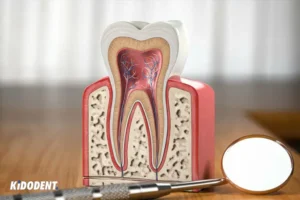Gum disease is the more common term that includes the more specific terms for gum problems including gingivitis and periodontitis.
What is gingivitis?
Gingivitis is the inflammation of the gum tissues (gingival tissues) surrounding teeth due to bacterial activity in the biofilm (plaque buildups) of marginal gum tissues around teeth. The difference between gingivitis and periodontitis is that in gingivitis gum inflammation occurs but not the attachment or bone loss as in periodontitis. Gingivitis is almost a widespread gum problem among children compared to severe gum problems like periodontitis.
Signs of gingivitis are:
- Redness of the gums
- Swollen gums
- Bleeding easily
- Gum enlargement can also happen
There are two types of gingivitis:
- Plaque-induced gingivitis: this type of gum problem starts with plaque accumulation. It can get worse due to dietary and existing systemic problems in people.
- Nonplaque-induced gingivitis: this type of gingivitis, which is also called gingival lesion, is caused by the bacteria, fungus and other viral bacterial activities. Genetic factors and trauma can also cause these gingival lesions.
What is periodontal disease?
Periodontal disease or periodontitis is the severe gum problem that causes bone loss, teeth loss and other severe problems in structures of gums that support teeth like alveolar bone. Periodontitis starts with gingivitis and if gingivitis left untreated, it can lead to periodontal disease.
Although the periodontal disease is not very common among children, the dentists’ examination can give clear picture of the gum condition in young patients.
Can gingivitis occur in children?
Almost anybody can be at risk of gum inflammation or gingivitis. Bacterial activity increases as the age goes up and oral hygiene is neglected. Eruption gingivitis is the common gum problem among children of 6 and 7 years old. This is the time of eruption of permanent teeth and the difficulty in erupting if accompanies poor oral hygiene can lead to gingivitis in children. During puberty, but, the gingivitis is more likely to happen because of hormonal changes. For example, girls around 10 years and boys of 13 years of age are at highest risk of gingivitis.
Causes of gum disease
The causes of gum disease in gingivitis and periodontal disease include:
- Dental calculus: dental calculus is masses of dental plaque and concentrations of these sticky masses can exist on different parts of teeth and enamel.
- Allergies: this may sound unusual but children with allergies like seasonal allergies are at higher risk of gum inflammation.
- Vitamin deficiencies: to prevent chronic gingivitis, which is another common gum disease, children should have sufficient amount of fruits and vegetables in their diets.
- Teeth defects and malocclusion: there should not be any favorable condition for gum disease to happen. Having defective teeth or restorations can make gingivitis a possible risk.
- Existing diseases like diabetes: as you know, diabetes is the disease that can occur at any age. Therefore, individuals should be aware of their diabetes level. Glucose levels in blood can impact the reaction of both gingivitis and periodontitis especially in inflammation and plaque biofilms.
- Smoking: those people who smoke are at greater risk of periodontal diseases compared with nonsmokers. The reason is the heat that is produced by smoking. The heat damages collagen and protein structure of the gums. The attachment loss, which is severe form of periodontitis, can speed up by heat of smoking. The immunoglobulin level in gums lowers due to smoking.
- There are more causes of severe gum problems including viral infections, bacteria accumulation and stress. Also, genetic disorders like hypophosphatasia and children with Down syndrome are at higher risk of gum diseases (gingivitis and periodontitis) due to immune deficiencies and abnormalities.
Treatment of gum diseases (gingivitis and periodontitis)
Gingivitis can be prevented by following oral hygiene tasks daily. Regular flossing and toothbrushing can offer the long lasting results in the path to oral health and teeth. In severe receding gums, gingival grafting can be the solution to keep the stability of teeth and gums.
As the plaque and bacteria are leading causes of gum problems, dentists recommend chlorhexidine mouthwashes. Chlorhexidine is a popular plaque control and disinfecting agent. It is safe and keeps the oral condition healthy. The dryness in the mouth might happen and you can consult with your dentist when using mouthrinses containing chlorhexidine.
Periodontitis can also be slowed down by oral hygiene activities. For aggressive periodontics, which is one type of periodontitis, the treatments can include bacteria elimination, cleaning the soft tissues of any debris and wound treatment (debridement), systematic therapies of medications, antibiotic application and surgeries.
